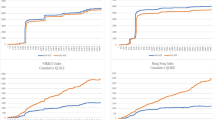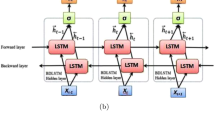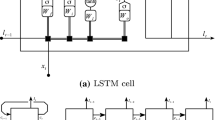Abstract
The importance of volatility modeling is evidenced by the voluminous literature on temporal dependencies in financial market assets. A substantial body of this literature relies on explorations of daily and lower frequencies using parametric ARCH or stochastic volatility models. In this research we compare the model performance of alternate neural network models against that of the (G)ARCH framework when applied to hourly volatility of FX futures options. We report that the results obtained from the application of a closed-form Bayesian regularization radial basis function neural network are considerably more efficient than those produced by alternate neural network topologies and the (G)ARCH model formulation.
Similar content being viewed by others
Explore related subjects
Discover the latest articles, news and stories from top researchers in related subjects.References
Andersen T. G. (2000). Some Reflections on Analysis of High-Frequency Data.Journal of Business & Economic Statistics vol. 18(2), 146–153.
Baillie R. and Bollerslev T. (1989). The message in daily exchange rates: A conditional-variance tale.Journal of Business & Economic Statistics vol. 7 297–306.
Beckers S. (1981). Standard Deviations Implied in Option Prices as Predictors of Future Stock Price Variability.Journal of Banking and Finance vol. 363–381.
Black F. (1976). The Pricing of Commodity Contracts.Journal of Financial Economics vol. 3(Jan–Feb), 167–179.
Bolland P. J., Connor J. T., and Refenes A.-P. N. (1998). Application of Neural Networks to Forecast High Frequency Data: Foreign Exchange, inNonlinear Modelling of High Frequency Financial Time Series, (B. Zhou, ed.). John Wiley & sons, Chichester, 225–246
Bollerslev T. (1986). Generalized Autoregressive Conditional Heteroskedasticity.Journal of Econometrics vol. 31 307–327.
Bollerslev T., Cai J., and Song F. M. (2000). Intraday Periodicity, Long Memory Volatility, and Macroeconomic Announcement Effects in the US Treasury Bond Market.Journal of Empirical Finance vol. 7 37–55.
Coats P. and Fant L. (1992). A Neural Network Approach to Forecasting Financial Distress.Journal of Business Forecasting vol. 10(4), 9–12.
Dacorogna M. M., Muller U. A., Nagler R. J., Olsen R. B., and Pictet O. V. (1993). A Geographical Model for the Daily and Weekly Seasonal Volatility in the FX Market.Journal of International Money and Finance vol. 12 413–438.
Elanyar V. T. and Shin Y. C. (1994). Radial Basis Function Neural Network for Approximation and Estimation of Non linear Stochastic Dynamic Systems.IEEE Transactions on Neural Networks vol. 5(4), 594–603.
Engle R. F. (1982). Autoregressive Conditional Heteroskedasticity with Estimates of the Variance of U.K. Inflation.Econometrica vol. 50 987–1008.
Ghysels E. A., Harvey A., and Renault E. (1996). Stochastic Volatility, inHandbook of Statistics, (G.S. Maddala, ed.). North Holland, Amsterdam,
Hutchinson J. M., Lo A. W., and Poggio T. (1996). A Nonparametric Approach to Pricing and Hedging Derivative Securities via Learning Networks, inNeural Networks in Finance and Investing: Using Artificial Intelligence to Improve Real-World Performance, (E. Turban, ed.). McGraw Hill, New York, Chapter 33
Jorion P. (1995). Predicting Volatility in the Foreign Exchange Market.The Journal of Finance vol. L(2), 507–528.
Kaastra I. and Boyd M. S. (1995). Forecasting Futures Trading Volume Using Neural networks.Journal of Futures Markets vol. 15(8), 953–970.
Kajiji N. (2001). Adaptation of Alternative Closed Form Regularization Parameters with Prior Information to the Radial Basis Function Neural Network for High Frequency Financial Time Series. InApplied Mathematics. University of Rhode island, Kingston.
Malliaris M. and Salchengerger L. (1996). Neural Networks for Predicting Options Volatility, inNeural Networks in Finance and Investing, (E. Turban, ed.). McGraw-Hill, New York, 613–622
Muller U. A., Dacorogna M. M., Olsen R. B., Pictet O. V., Schwarz M., and Morgenegg C. (1990). Statistical Study of Foreign Exchange Rate, Empirical Evidence of Price Change Scaling Law, and Intraday Analysis.Journal of Banking and Finance vol. 14 1189–1208.
Nelson D. B. (1991). Conditional Heteroskedasticity in Asset Returns: A New Approach.Econometrica vol. 59 pp. 347–370.
Niranjan M. (1997). Sequential Tracking in Pricing Financial Options using Model Based and Neural Network Approaches, inAdvances in Neural Information Processing Systems, (M.C. Mozer, Jordan, Michael I., and Petsche, Thomas, ed.). The MIT Press, Boston, 960–972
Olaf W. (1997). Predicting Stock Index Returns by Means of Genetically Engineered Neural Networks. InDepartment of Management. University of California, Los Angeles.
Refenes A. N. and Bolland P. (1996). Modeling Quarterly Returns on the FTSE: A Comparative Study with Regression and Neural Networks, inFuzzy Logic and Neural Network Handbook, (C.H. Chen, ed.). McGraw-Hill, New York, 19.1–19.28
Sohl J. E. and Venkatachalam A. R. (1995). A Neural Network Approach to Forecasting Model Selection.Information Management vol. 29(6), 297–303.
Author information
Authors and Affiliations
Corresponding author
Additional information
The research reported in this manuscript was supported by a grant from The NKD Group, Inc. Wilmington, Delaware (www.nkd-group.com).
Rights and permissions
About this article
Cite this article
Dash, G.H., Hanumara, C.R. & Kajiji, N. Neural network architectures for efficient modeling of FX futures options volatility. Oper Res Int J 3, 3–23 (2003). https://doi.org/10.1007/BF02940275
Issue Date:
DOI: https://doi.org/10.1007/BF02940275




